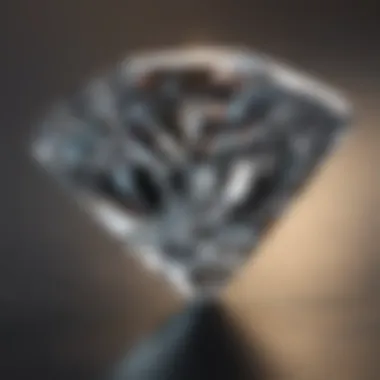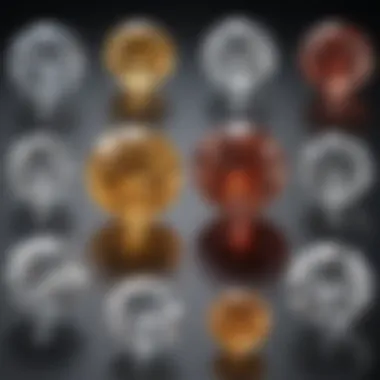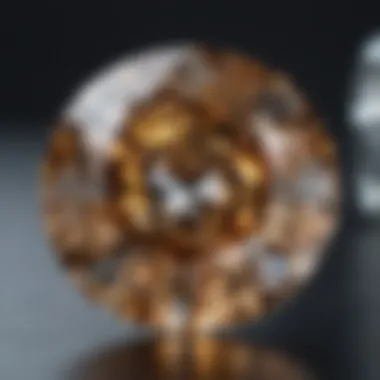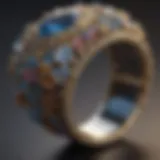Determining the Optimal Diamond Cut: A Comprehensive Guide


Intro
The world of gemstones offers a plethora of choices for jewelry and design, with diamonds often leading the pack due to their unique brilliance and ability to captivate. Yet, the variation in diamond cut plays a critical role in determining not just their appearance, but also their market value. In this investigation, the focus shifts towards elucidating how to accurately identify the optimal diamond cut amidst the myriad of shapes and styles available.
Overview of Gemstones and Minerals
Understanding gemstones, particularly diamonds, requires more than just recognition of their beauty. These minerals have profound historical and cultural footprints across societies. Throughout history, gemstones have been symbols of wealth, power, and even spirituality.
History of Gemstone and Mineral Use
Traditionally, gemstones have been revered across civilizations. Ancient Egyptians, for example, utilized turquoise and lapis lazuli not solely for adornment but as means of harnessing protection in the afterlife. As centuries progressed, usage evolved. In the Middle Ages, rubies and sapphires adorned crowns and vestiges of nobility.
Significance in Culture and Society
In contemporary times, diamonds became the apex of expression in romantic gestures, indicative of commitment and trust. Their mystical allure, accompanied by industrial uses, has further anchored their relevance in today’s culture.
Gemstone Formation and Properties
The richness of gemstones occupies deep within geological processes. Each stone undergoes a unique formation, which contributes to its characteristics.
Formation Process of Gemstones
Gemstones form through intricate processes involving natural heat, pressure, and sometimes, fluid crystallization. For instance, diamonds require conditions deep within the Earth, specifically temperatures around 1,300 to 2,500 degrees Fahrenheit, and pressures exceeding 725,000 pounds per square inch.
Properties that Define Gemstones
Various properties characterize gemstones. These properties include hardnss, luster, and color, contributing to not only the gemstone's aesthetic appeal but also its applicability.
Classification based on Color, Hardness, and Luster
Above factors are pivotal when classifying gemstones.
- Color: A crucial aspect that influences desirability.
- Hardness: Refers to a gemstone’s ability to withstand scratches. Diamonds score the highest at 10 on the Mohs scale.
- Luster: Signifies the way a surface interacts with light.
Types of Gemstones
Systematic exploration of gemstones divides them into distinct types based on their preciousness, rarity, and industrial utility.
Precious vs.
Semi-Precious Gemstones
Historically, diamonds are viewed as precious; alongside sapphires, emeralds, and rubies. Other stones fall under semi-precious but hold unique qualities influencing demand. Popular semi-precious gemstones include amethyst and aquamarine.
Common Gemstone Varieties
Different varieties appeal due to availability and cultural value. Popular gemstones feature diamonds, emeralds, topaz, and tourmaline among others. Each variety boasts unique characteristics, attracting various niche markets.
Exotic and Rare Gemstones
Some gemstones are so rare that they attract fascination among collectors. Stones like jadeite and Painite fall into this category, conveying a market where value is derived from scarcity rather than size or shape.
Identifying and Evaluating Gemstones
Understanding how to evaluate gemstones can inform purchases significantly. Familiarity with evaluative criteria can guide decisions effectively.
Factors Affecting Gemstone Value
Several factors determine the value of a gemstone:
- Clarity and Flaw Presence: Any imperfections can substantially affect value.
- Cut Quality: Highly skilled cutting translates to better light reflection.
- Carat Weight: Larger stones generally command higher prices per carat.
Techniques for Gemstone Identification
Techniques such as refractometry, spectrometry, and even simple visual assessments are a few methods instrumental in identifying gemstones data inspired by research methods within geology.


Assessing Gemstone Quality
Quality adds intricate behaviors in markets. Tracking provenance and certification from entities like the Gemological Institute of America can be critical when verifying authenticity and distinguishing products.
Caring for Gemstones
The treatment of gemstones involves multiple facets, enhancing their lifespan and retaining brilliance.
Cleaning and Storing Gemstones Properly
Regular cleaning distracts buildup without causing damage. Mild soaps with soft brushatorial tools work well while storage requires avoiding direct contact with other hard materials.
Avoiding Common Mistakes in Gemstone Care
Using harsh chemicals or subjecting gemstones consistently to excessive moisture depletes their quality. Understanding specifics allows gemstone owners to practice care judiciously.
Preservation Tips for Specific Gem Types
Certain geological formations may incur additional care approaches. For example, pearls require avoidance—good tips include keeping them away from perfumes or cosmetics.
Understanding Diamond Cuts
In the world of gemstones, diamond cuts play a pivotal role in determining the aesthetics and value of these precious stones. This section aims to clarify the significance of diamond cuts for both enthusiasts and professionals. Understanding what a diamond cut is and how it influences a diamond's characteristics can help buyers make an informed choice. Moreover, it enhances the overall appreciation of the stone's beauty and craftsmanship.
What Defines a Diamond Cut
A diamond cut refers to how a diamond is shaped and faceted. It is distinct from the diamond’s shape like round or pear, and it conveys the diamond's actual quality. A well-cut diamond reflects light internally and externally, maximizing brilliance and fire. Factors inherent to the cut include the quality of craftsmanship, width, depth, angles, and proportions. Optimal measurements can lead to enhanced light performance, ensuring the diamond sparkles under various conditions.
Digital analysis and advanced geometrical tools have transformed how cut quality is assessed. Important characteristics of a cut include:
- Brightness: The light reflected from the gem.
- Fire: The dispersion of light into various colors.
- Scintillation: The flashes of light that result from movement.
These attributes represent explicit measures of the diamond's aesthetic appeal. Therefore, analyzing these particulars has widespread implications for the discernment of cut quality when considering a gem purchase.
Importance of Cut in Diamond Selection
The cut of a diamond greatly influences not only its appearance but its market value as well. A diamond graded as “Excellent” in cut can wow a buyer, while one with a “Poor” cut can diminish perceived value substantially, irrespective of the rough stone's quality. The distinction becomes crucial when people decide on the best stuff for specific occasions.
For jewelry designers and consumers, personal preference intersects here. Each individual who encounters a diamond has particular views on how much dazzle should be expected. Factors affecting this choice include:
- Personal Taste: Different shapes will suit different styles, making preferences subjective.
- Setting Types: Some cuts have advantages in specific settings, influencing purchasing decisions.
The implications of these cut characteristics extend beyond mere visual effect; they serve as fundamental considerations in integrations with various gemstones. Understanding both cut definitions and their consequences enables customers to invest wisely in diamonds that instill long-lasting value.
“A diamond’s cut directly controls its sparkle. Choosing the right cut can be as significant as prioritizing the gemstone's clarity or color.”
Types of Diamond Cuts
The selection of a diamond cut significantly influences its overall appeal and brilliance. Different types of cuts exhibit unique characteristics, which can affect a diamond’s sparkle, shape, and how it fits individual preferences and occasions. This section provides an in-depth exploration of various diamond cuts to help you understand essential benefits and considerations when making a choice.
Brilliant Cut Diamonds
Brilliant cut diamonds are known for their finely crafted facets. This design optimally reflects light, resulting in a diamond that has significant sparkle and shine. The cut boasts a round shape and typically has 58 facets. This design allows exceptional light performance, making these diamonds particularly popular in engagement rings. Additionally, the symmetry of a brilliant cut enhances its overall value, as cut quality is one of the key determinants when evaluating a diamond.
Princess Cut Diamonds
The princess cut combines traditional and modern style. It retains about 76 facets, which increase its light reflection capability. This cut, with its square or rectangular shape, offers a contemporary alternative to round brilliant cuts, often preferred for its sharp lines and geometry. The princess cut excels in showcasing color, making it a great choice for more saturated stones. Its versatility exists in various types of jewellery.
Emerald Cut Diamonds
Emerald cut diamonds are known for their elegance and step-like appearance, featuring fewer facets—generally around 58—which create a unique type of light performance. The large table surface refracts light differently, emphasizing clarity over sparkle. Perfect for those who favor sophistication, this cut is often used in vintage and modern designs. They reveal color inclusions more readily, making stone quality a key factor for buyers.
Round Cut Diamonds
Round cut diamonds hold the title for being the most popular diamond shape. Designed meticulously, including a total of 58 facets, round cuts maximize light reflection, ensuring brilliant fire and sparkle. This cut's balanced symmetry attracts various customers. Informally deemed as timeless, it provides flexibility for different jewellery settings and pairs well with various designs, making them a preferred option for engagement settings.
Asscher Cut Diamonds


Asscher cut diamonds resemble the emerald cut but with a square shape and cropped corners. Just like the emerald cut, it focuses heavily on clarity. This design showcases depth with its large facets and distinctively cut table. It typically has around 58 facets. Although it may not exhibit the same fire as rounded cuts, its classic style appeals to those seeking something refined.
Marquise Cut Diamonds
Marquise cut diamonds have an oval trap with pointed ends, which maximizes carat weight, giving the appearance of a larger stone. With approximately 58 facets, the way it captures light contributes to its impressive reflectivity. Historically, this cut has represented elegance. Buyers should note the inherent cleavage vulnerability. To minimize chipping risks, consider protective settings.
Oval Cut Diamonds
Oval cut diamonds provide a modern shape akin to the round cut but extend its adaptability as the elongation can create a larger appearance without the expense typically associated with larger carat weights. This cut maintains its brilliance with the same facet design as round cuts. Popular for those wanting a unique yet classic alternative, ovals are fitting choices for daily wear.
Cushion Cut Diamonds
Cushion cut diamonds combine a square aspect with rounded corners, resembling a pillow. Featuring about 64 facets, this cut has surged in popularity due to its sparkling effect. It famed comes from antique cuts but many modern updates increase light scattering. The cushion can combine both old and new aesthetics to appeal to various tastes.
Radiant Cut Diamonds
Radiant cut diamonds blend the brilliance of round cuts with the body of an emerald, delivering dynamic sparkle. With 70 facets, their luminosity is outstanding in all types of light. It comes in both rectangular and square shapes, appealing to diverse preferences. Same as princess cuts, they maintain extraordinary multi-faceted attributes.
Understanding these various diamond cuts is crucial in making an informed decision. This knowledge not only helps in selecting the right piece but also enhances your appreciation of diamond craftsmanship.
The Influence of Cut on Diamond Brilliance
The diamond cut is a fundamental aspect that plays a critical role in determining a diamond's brilliance and sparkle. A well-executed cut allows a diamond to reflect light efficiently, resulting in a visually appealing stone. Understanding this aspect not only enhances appreciation for the diamond but also guides buyers in selecting a stone that meets their preferences and needs.
Understanding Light Performance
Light performance refers to how effectively a diamond interacts with light. It encompasses activities beyond mere reflection; it includes how light enters the diamond, reflects off its facets, and refracts back to the observer's eye. This process contributes significantly to the diamond’s appearance and how brilliant it looks.
Diamonds are not merely stones; they are optical phenomena. The most critically acclaimed cuts, which include excellent proportions, symmetry, and polish, enhance the performance of light.
To comprehend light performance, one should not overlook the concepts of brilliance, fire, and scintillation:
- Brilliance: This is the reflection of white light that comes from within the diamond. A diamond cut for maximum brilliance has good angles and proportions enabling optimal light reflection.
- Fire: This terms the dispersion of light into a spectrum of colors. A diamond cut to maximize fire creates light flashes colored like a rainbow.
- Scintillation: This describes the twinkle effect caused by the movements of the diamond and the play of light across its facets.
Recognizing these qualities when evaluating the cut of a diamond will help in understanding how much sparkle lies within the chosen diamond.
Factors Affecting Brilliance
Several factors influence the brilliance of a diamond, and they include:
- Cut Quality: The precision during the cutting process directly affects a diamond's brilliance. Deviations in angles, proportions, and symmetry can contribute to light leakage, reducing the overall sparkle.
- Proportions: Specific measurements play a role. For example, the table size, crown angle, and pavilion depth can determine how well the diamond captures and reflects light. Certain outline parameters yield optimal results when dimensions are correctly aligned.
- Facet Arrangement: The way the facets are cut and arranged impacts how light travels within the diamond. Smaller, strategically placed facets improve sparkle when they catch light from various angles.
- Polish and Symmetry: A diamond that has a smooth finish allows light to flow uninterrupted. Symmetry affects how light traverses the facets of the diamond. An imbalanced symmetry may lead to uneven illumination.
Furthermore, potential buyers should consider how other elements interact with the cut of the diamond, including setting and the surrounding environmental effects like lighting conditions when assessing brilliance.
Understanding how different factors affect cut is essential in discerning quality from mediocrity. A well-cut diamond can significantly elevate the overall scintillation of the gem.
Considering these aspects empowers the purchaser to make an informed decision. An informed understanding of these factors unveils the significance of cut, directly correlating with the brilliance of a beautiful, precious diamond.
Evaluating the Quality of a Diamond Cut
Evaluating the quality of a diamond cut is crucial for anyone interested in acquiring the perfect gemstone. This process affects various aspects of the diamond, such as its light performance, visual appeal, and overall value. Understanding how to assess the cut quality is essential for consumers as it determines not only the beautifying aspects but also the long-term satisfaction with the jewel.
There are specific elements to consider when evaluating the quality of a diamond cut, such as cut grades, precision, and symmetry. Each of these factors plays a significant role in the imagery of the diamond and its capacity to reflect light structure vividly and clearly. By analyzing these elements comprehensively, buyers can make informed decisions aligning with their personal tastes and investment objectives.
Cut Grades Explained
Cut grades act as a guide to assess how well a diamond has been cut. The grading standards for diamond cuts can differ slightly among grading institutions, but they generally follow a similar rubric. Most notably, grades usually range from Excellent to Poor. Understanding these grades assists shoppers in narrowing down their selections.
Factors Used in Grading:
- Brilliance: The overall brightness of the diamond when it reflects light.
- Fire: The colorful flashes and reflections produced by the diamond.
- Scintillation: The twinkling effect you observe when the diamond moves.
The following breakdown explains what the grades typically signify:
- Excellent: Exceptional light performance, requires precise measurements.
- Very Good: Solid performance; minor deviations in angles or proportions.
- Good: Average gains in sparkle, more variation in light behavior.
- Fair: Noticeable issues with appearance, light reflection less desirable.
- Poor: Lacks brilliance; major flaws in cut may affect value significantly.


The Role of Precision and Symmetry
Precision and symmetry dictate the quality of crafted diamonds. The artistry in cutting a diamond affects its brilliance and overall aesthetic. A diamond cut with precision will more efficiently allow light to enter, dominate, reflect, and exit, elevating its regal quality. Moreover, symmetry ensures that every facet aligns perfectly.
The degree of symmetry is evaluated methodically. The better the symmetry, the more directives the viewer's eye has through the jewel. Common evaluations can include:
- Facet Alignment: Are the facets exactly equal?
- Reflective Patterns: Do they mirror accurately?
An assessment of these characteristics and thorough understanding can significantly raise the trust in guessing a diamond's performance visually and in terms of investment. Analysts often recommend selecting pieces that claim even small margins of error in measures over more
Choosing the Best Diamond Cut
Selecting the right diamond cut is a primary decision for buyers. This aspect determines not only the aesthetics of the gemstone but also its overall appeal and brilliance. Each person's taste can differ substantially, which is why understanding individual preferences and mindful selection is crucial.
Choosing the best diamond cut requires a thoughtful approach. Among the myriad of shapes, each cut bears its own personality, shining differently under various lighting and settings. For any buyer, aligning personal vision with cut attributes can lead to a satisfying purchase. Furthermore, an ideal cut enhances the diamond's innate characteristics, providing greater visual allure.
Personal Preference and Style
Personal preference plays a vital role in the choice of diamond cut. Factors such as personality, lifestyle, and desired aesthetic outcome strongly influence the decision. Here are ways to discern one’s preferences:
- Researching Different Cuts: Familiarity with cuts like the round or emerald can indicate what resonates most.
- Trying on Jewelry: Experiencing different pieces can help understand which cut feels most appealing on the finger.
- Considering Design Flexibility: Some cuts complement specific band styles better than others, affecting overall look.
Ultimately, personal style acts as a guiding principle in the selection process. A boxer might opt for the robust and unconventional marquise cut, while a minimalist might favor a classic round cut. Therefore, knowing oneself can prevent future regrets.
Considerations for Different Occasions
Diamonds often represent significant milestones, from engagements to anniversaries. The cut chosen can influence how well the piece suits the occasion. Each context brings unique considerations:
- Engagement Rings: Traditionally lean toward rounds or princess cuts due to their elegance and timelessness.
- Anniversary Celebrations: An emerald or cushion cut can embody the romantic evolution, matching personal journeys.
- Everyday Wear: For daily adornment, durability matters. Consider cuts that resist wear, such as oval or radiant.
Furthermore, understanding these nuances can enhance emotional attachment to the jewelry. This personalized approach solidifies its significance as more than a mere ornament, but a lasting symbol of life's meaningful moments.
“Choosing a diamond cut is not just about aesthetics; it's about telling one's story and embodying one's essence through the piece.”
The Art and Science of Diamond Cutting
The diamond cut is not just a mere aesthetic choice; it serves as the foundation for the stone's brilliance and value. Understanding the art and science of diamond cutting reveals the meticulous interplay of geometry, craftsmanship, and technology. Exploring this aspect not only illuminates its historical significance but also spotlights modern innovations that redefine the field. Such knowledge is essential for buyers, gem enthusiasts, and industry experts. It allows them to appreciate not just the beauty of the diamond, but also the intricate processes that contribute to its charm.
Historical Context of Diamond Cutting Techniques
The evolution of diamond cutting is a story of human ingenuity. Early cutting techniques date back to the 1300s, where diamonds were primarily polished with primitive tools. They relied on the natural beauty and irregular shapes of rough stones. Over centuries, the methods metamorphosed due to advances in technology and the growing appetite for ornate jewelry.
The transition from the heavy, basic cuts to the more sophisticated ones showcases the blend of artistry and engineering.
- The table cut emerged as one of the first refined shapes, emphasizing the flat top and shine.
- The advent of the rose cut introduced facets that tapped the beauty of light performance.
- The introduction of the faceted brilliant cut in the 17th century was a landmark moment. It offered enhanced fire and scintillation, captivating the interest of gem lovers globally.
This historical context not only informs current practices but also defines the cultural significance of diamonds through the ages. Those aware of this background can make more informed choices about their purchases.
Modern Technologies in Diamond Cutting
Today, the field of diamond cutting has transformed immensely with technological advancements that mechanize what was once done solely by hand. Automation has led to improvements in precision and consistency, essential characteristics in achieving ideal cuts. High-tech machines can analyze rough diamonds and determine optimal faceting with accuracy previously deemed impossible.
- Laser Cutting: A distinguishing method that employs lasers to cut diamonds with extreme precision. This allows for intricate designs and maximizes the yield from rough stones.
- Computer-Aided Design (CAD): Innovative software lets cutters visualize designs, modifying geometries before the physical cutting begins, optimizing both aesthetics and performance.
- Artificial Intelligence: AI can predict light behavior in gemstones, leading to better understanding of stone aesthetics. It produces detailed reports about the best possible cutting strategies before manual intervention.
The intersection of these technologies does not just speed up production but ensures that each diamond is cut to maximize brilliance and beauty. Understanding this modern cutting landscape enables buyers to appreciate the value of the craftspeople and technologists involved in this intricate process.
Closure: The Optimal Cut for Your Needs
Choosing the right diamond cut is paramount to achieving the desired aesthetic and value in your selection. Each diamond cut offers a unique set of qualities that can influence the overall appearance, performance, and personal significance of the stone. This section will summarize essential insights while providing practical recommendations for potential buyers.
An optimal cut ensures that the diamond not only catches the eye but does so according to what one prioritizes — whether it's brilliance, style, or budget considerations. Understanding the individual characteristics of each cut informs how they differ in play of light and visual impact. A well-informed choice ultimately results in a piece that resonates with the wearer's personal style and the intended occasion.
Summary of Key Insights
- The Role of Cut Quality: The diamond cut is a critical criterion in assessing overall quality. Its precision correlates to the diamond's ability to reflect and refract light, enhancing its brilliance.
- Personal Taste Matters: Different cuts attract different preferences, making it equally essential to evaluate one's style alongside aesthetic qualities.
- Occasion Relevance: Various cuts are better suited for particular events or types of jewelry, further weighing in on the decision-making process.
- Value Consideration: The cut often impacts market value, meaning enthusiasts should approach buying strategically, making engament cuts more valuable.
Final Recommendations for Diamond Buyers
- Assess Personal Style: Take time to reflect on which diamond cut resonates with you. The diamond should reflect not only aesthetic appeal but your personality.
- Prioritize Cut Quality: Focus on the grading of cuts. A diamond graded as excellent or ideal is often preferable for optimizing brilliance.
- Consider Usage: Think about when and how the diamond will be worn. Certain cuts work better in rings, while others may complement pendants or earrings more elegantly.
- Budget Evaluation: Discuss your budget before falling for a specific cut, allowing for flexibility when exploring alternatives.
- Do Your Research: Familiarize yourself with credible sources and reviews. Understanding characteristics associated with different cuts can aid in making informed decisions.
Knowledge is key when discerning which diamond cut best fits your needs. This comprehensive approach will not only assist in achieving a desired look but will also serve as an investment that appreciates over time.
In the pursuit of selecting your ideal diamond cut, take advantage of available resources. This journey, when grounded in information, holds the potential to yield a truly exceptional piece.







